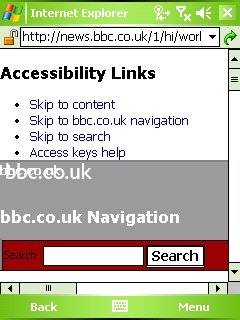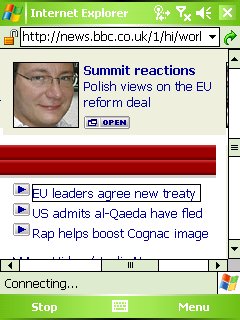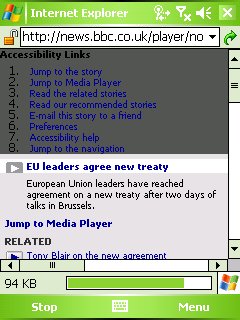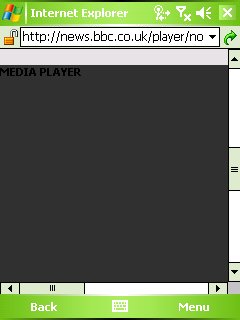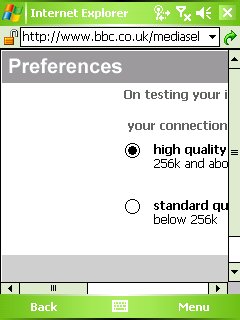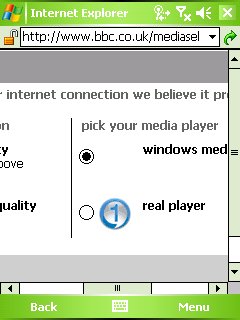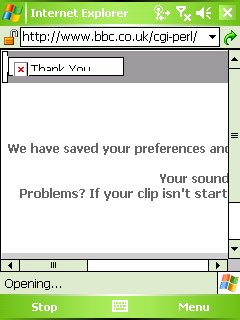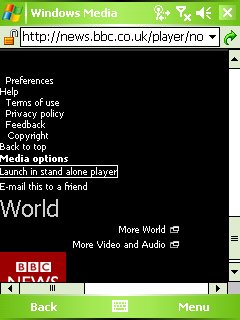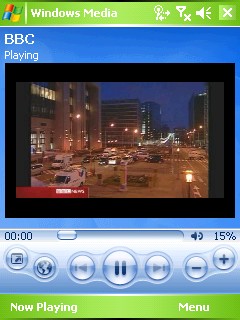Having purchased the HTC P3600 (aka Trinity) earlier this year, I thought now might be a good time to look back and pick out the applications that I’ve found most useful on a regular basis - the handheld ‘bread and butter!’ So here they are listed in no particular order, with some quick summary notes.
1. QMAIL3
http://q3.snak.org/en/
I have been using this mail client for several years, initially with the HP Jornada 720 (Handheld PC2000). Now I use it with the Trinity, mainly just to keep informed whilst away; I occasionally compose a few short messages and send attachments, but it’s mainly for reading. It’s very powerful, providing good support for the IMAP server at work (e.g. can sync on any number of folders) and quite a number of configurable options in the interface, including HTML support and message threading, though it is somewhat cramped on the QVGA display.
2. Tomeraider + Wikipedia (snapshot with images)
http://en.wikipedia.org/wiki/TomeRaider
This was the combination that almost single-handedly removed my dependence on the clamshell form factor. For general facts and figures, Wikipedia is an excellent resource and thanks to Erik Zachte versions of the database have been made available for ready conversion to Tomeraider, an e-book reader whose clever indexing and nifty interface makes accessing and navigating entries a breeze. It usually takes me just a few seconds from switching on the PDA to tapping out the topic under investigation; the version I have also includes small versions of about 2/3 of the original images.
However, the outputs from Wikipedia have been changing from time to time, too much to keep up with, so at present there is not an up-to-date version of the full text that can be read in Wikipedia, certainly not one with images. Alas, the conversion process stalled some while ago. I still hope that some initiative will emerge that enables it to become active again. One area that has been considered is the production of subsets according to particular categories – that at least is an interesting research project!
Working with this combination has sparked quite a few thoughts aboiut which I'm still pondering – first about PDA clients (thick or thin?) and then using this educational resource as the basis of what might become One PDA [or smartphone] per Child, which prompted thoughts in the sphere of education from Leonard Low - One PDA Per Learner (OPAL). With the iPhone bring handheld devices very firmly out of business confines and the emergence of various initiatives concerning small laptops, this looks increasingly likely in the mid term.
3. ZIP for Pocket PC
http://htc-zip.en.softonic.com/pocket
A utility to unpack ubiquitous Zip archives is essential for document bundles, installation files etc. HTC’s offering (Version 1.20) is easy to use and quite flexible in the extraction options.
4. Outlook/Google calendar via Oggsync
http://oggsync.com/
http://www.google.com/calendar/
I have been making daily use of the pocket Outlook client and it works well, obviously has been given a lot of attention for business users. It is a real boon to sync it with Google Calendar – I was hoping for a free client to cover all my needs, but I think for a reasonably reliable and functional product decided it was worth paying for Oggsync, even though I think the licensing model (annual payment) is questionable as it is software that is being provided, not an online service.
I currently sync on 3 calendars: a personal calendar, a work calendar and a public calendar that gives dates of Oxford terms. Google has many public calendars that are worth perusing.
5. Contacts
Similar to the calendar, on using the phone more, I have been storing and updating contacts here.
6. Windows Media Player
[Audio]
One of my Thai friends very kindly scoured Chulalongkorn University bookshop and subsequently presented me with two self-study Thai language courses called ‘Thai for Beginners’ and ‘Thai for Intermediate Learners’ by Benjawan Poomsan Becker. They came with cassette tapes that I’ve digitized into mp3 format [technicalities described in another post]
I still take the physical book with me, but use the phone to listen to the audio. There are better audio players, e.g. GS Player, but WMP does the job okay.
[Video] I use Windows Movie Maker on a laptop to transcribe videos produced by the Thai temple that I support (see e.g. DMC TV). They are typically made available as .wmv downloads or if collecting on CD they may be supplied as MPEGs encapsulated in VideoCD format (just rename the DAT file). Transcription is straightforward and the output option of PDA (320*240) produces good results. :-)
7. MS Live Search Mobile
http://livesearchmobile.com/
Of the various mapping applications that I’ve tried, I’ve found Live Search to be the most robust. If I’m visiting somewhere I download the tiles in advance. Then, when using that map data, the application works fine and won’t crash when you explore the edges.
8. Camera: pictures and videos
I’m not much of a photographer, but even I find it very easy to take snaps with the Trinity – just switch on and press the camera button twice. A nice feature is that it is integrated with the GPS, so you have the option of recording GPS data in the EXIF file.
Quality is modest, though with the CMOS sensor it works quite reasonably in low light conditions. I’ve uploaded a few to my Flickr space.
9. VisualGPSce
http://www.visualgps.net/VisualGPSce/
This application is well made. In the absence of any GPS application with the HTC ROM upgrade I use this to establish connections and then switch to other apps, e.g. the camera, knowing that a lock is available immediately.
It introduced me to the fun of GPS and digital maps, including a little detective trail and route animation (not sure about the practical value of that!)
10. Adobe Reader
http://www.adobe.com/products/acrobat/readstep2_mobile.html
A lot of documentation, especially work-related is distributed as PDF, so it’s necessary to have a PDF viewer. Adobe’s offering works reasonably well, though unless text flow works, then it’s not very practical to read more than a page or two.
Others
There are other apps that I’ve used occasionally, including:
- Supersnap: the best tool I’ve found for capturing a sequence of screenshots. The developer was very responsive to comments.
- Skype: For the Trinity, I needed to download version 2.1 (2.2 doesn’t work), the latest beta version of which I obtained via archive.org. It works okay, quality fair - I made one overseas call that lasted over an hour and found that although the audio sounded processed, it was clear enough. The main limiting factor is the phone contract, which prohibits its use, along with instant messaging. :-(
- MS Powerpoint viewer: for presentations that I prepare and similarly from others
- GS Player: I use it occasionally to listen to streams, as delivered by Shoutcast.com; can connect the output to the Hi-Fi. It’s a smart application with a very neat and tidy interface.
- XnView for Pocket PC: it’s a great graphics package, which I use to convert screenshots from BMP to GIF and then can upload to the Web.
- Word mobile: it’s limited, but sometimes that’s enough :-)
- Lingvosoft Thai-English dictionary for Pocket PC: I’m just starting to learn to read and write Thai and this is starting to help me more, though I first need to learn the alphabet! It comes with a virtual Thai keyboard and I can copy and paste Thai words to/from Pocket Word, so I hope eventually to be composing blog posts in Thai :-) It is has a large number of entries, more than adequate. The 2006 version that I bought supports speech synthesis, but for English only!
As this year draws to a close, I'd just like to say thanks for reading - I hope there's been something worthwhile for you. More thoughts in 2008...
Labels: 2007, applications, HTC, P3600




